Who knew that a printed photograph could be so damaging to the environment? Hannah Fletcher does. A photographic artist and member of the London Alternative Photography Collective, Fletcher is concerned about the litres of water necessary to wash films and prints, the resin-coated paper going to landfill, the harsh development and fixing chemicals as well as the heavy metals polluting soils and aquatic systems, the bovine gelatine coating paper and films, etc.

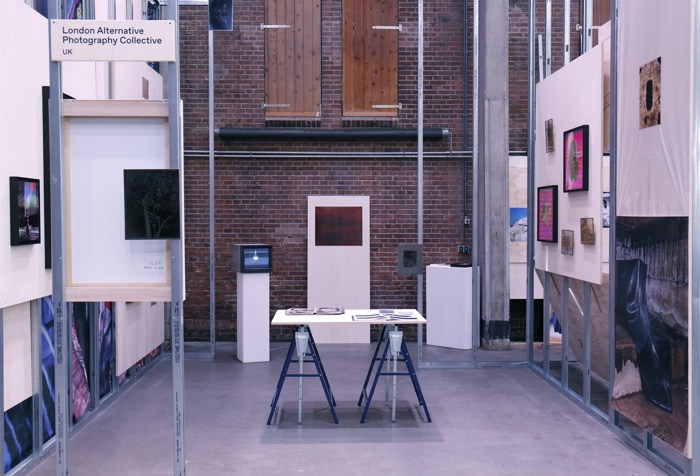
Hannah Fletcher, What Remains: The Root and The Radical, with London Alternative Photography Collective at Unseen photo festival, 2018
Her own artistic work demonstrates that this toxic assault on ecosystems is not unavoidable. Fletcher is a photographer without a camera who combines techniques from the past and experiments to innovate and improve photographic processes. Instead of the usual image-making tools, she uses light, paper, chemicals but also organic materials such as soils, algae, mushrooms and roots. She even set up The Sustainable Darkroom Project, a research, training and mutual learning programme to equip cultural practitioners with skills and knowledge that will help them develop an environmentally friendly photographic practice.
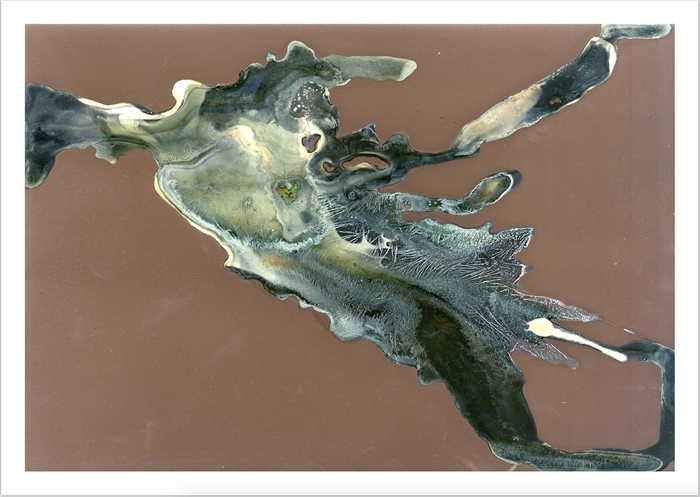
Hannah Fletcher, Algology: The Art of Scientific Curiosity, 2016
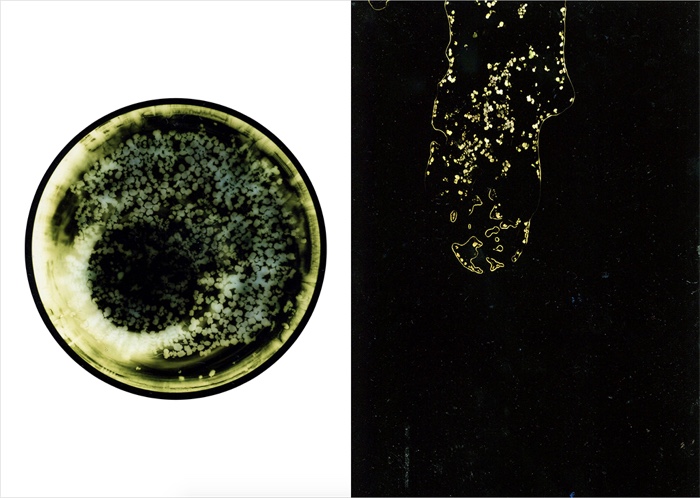
Hannah Fletcher, Algology: The Art of Scientific Curiosity, 2016
Hi Hannah! I was shocked when I read the description of The Sustainable Darkroom Project, the “artists run research, training and mutual learning programme aims to equip cultural practitioners with new skills and knowledge to develop a more environmentally friendly analogue photography / darkroom practice.” I am very interested in looking at the ecological footprint of pretty much everything but I had never considered the footprint of analogue photography. Could you give us an idea of the impact that analogue photography / darkroom practice have on the environment?
I find that the material impact we have as artists is often left by the wayside. We are taught that ‘art has no boundaries’, but if we want to keep working with these processes and materials, then, at some point we need to realise that the planet has limitations and we need to take better care not to overstep those boundaries. If the materials and processes we are using are not sustainable longterm then we need to rethink the way we are doing things.
In Analogue photography some of the issues include the toxicity of the chemicals, the unsustainable silver mining, the gelatine being an animal derived product and therefore helping to fuel the meat industry, the high volumes of water that are used for washing films and prints, the resin coating on papers – deeming them un-recyclable and therefore going to landfill… etc.. I could go on.
What would you say to someone who tells you that if analogue photography has such an impact on the environment, then we should all switch to digital photography and a large part of the problem would be solved? Surely, it is more complicated than that?
We aren’t going to solve the worlds problems by just moving everything digital. Digital photography has its own set of environmental issues and these are actually a very similar set of problems to analogue photography, only the materials are slightly different. Concerns of pollution, toxicity, exploitation, disposal, etc. caused by regular upgrades and the lack of safe disposal of old models; constant unsustainable mining of the rare earth minerals that make up the components of the camera; storing all of the files and images on cloud storage systems, etc. These devour vast quantities of energy and emit enough heat to melt themselves. Cooling systems, using more energy, are used to combat this waste heat. Even when data is not being accessed, they sit idle, ready and waiting for a surge in activity. Consequently, these centres can waste 90% or more of the electricity they pull off the grid.
All these issues and more are just as important to consider in the material relationships that make possible the existence of digital cameras/smartphones.
How did you get into cameraless photographic processes?
At school, when I first started studying photography we had access to a tiny cupboard like-darkroom. Only 1 person could use it at a time, so there was never anyone else there to tell you that you were not dong things the ‘correct’ way. This was where I would spend a lot of my spare time. It was here that I started to play around with the process of developing prints. One afternoon, I noticed a few prints in the bin that had been thrown away before being fully fixed. In their wet state, they had stuck to the plastic lining of the bin, causing an impression of crumpled plastic to be left on the prints as they continued to absorb light and react to their environment. I was so intrigued by the relationship between the photographic surface and this plastic bin bag; a non-photographic material. From there, gradually more and more my practice moved away from taking photographs with a camera.
Some of the techniques you work with (photograms, chemigrams, cyanotype, lumen prints, anthotype, Xerograph, pinhole camera, etc.) are not new. Does this automatically mean that there is no innovation, no research in the processes and material you work with? That if you want to be environmentally-friendly you are bound to look towards the past?
Amongst the techniques and processes I play around with, there is always something new. Many of the processes are near impossible to get the same results twice, it is an unpredictable method of making images. Often the result is haphazard and unsuccessful, as I attempt to control and dictate the outcome, it becomes a collaboration between the materials and me. I am continually thinking about new materials and ways to integrate those materials into the process of photographic print making. I do not see these techniques as individual methods of working, but as a set of knowledge, that I can combine and alter, adapt and morph according to my needs. techniques flow into one another, there is not always a need to categorise and label the way you are making work.

Hannah Fletcher, Circles: A Record of Our Time, 2017
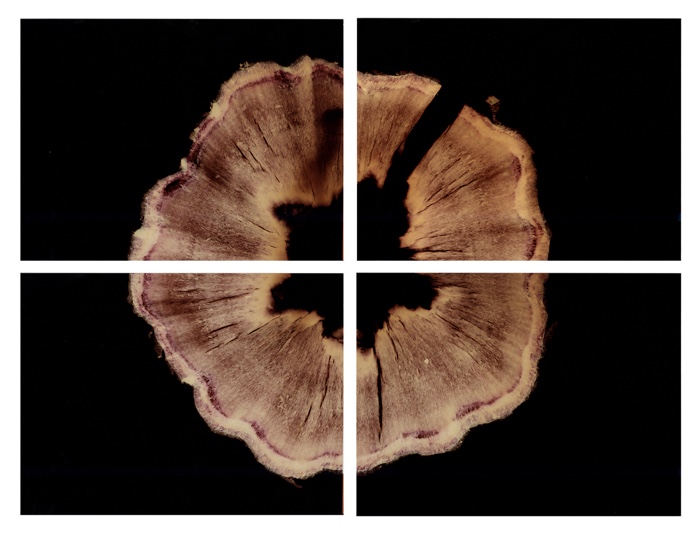
Hannah Fletcher, Circles: A Record of Our Time, 2017
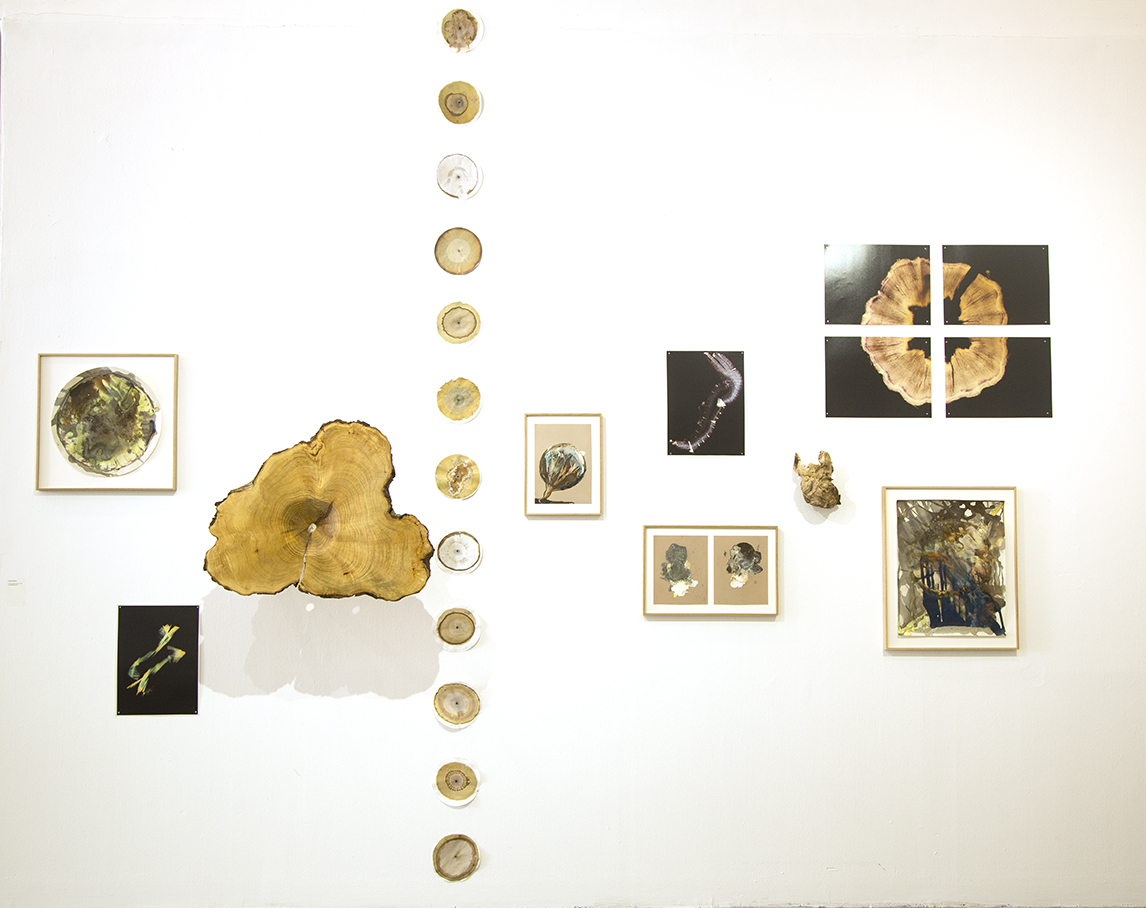
Hannah Fletcher, Circles: A Record of Our Time, 2017
Circles: A Record of Our Time illustrates (as far as I can tell) the mix of old techniques and current scientific research that characterises much of your work. The series is a visual recording of the Anthropocene in tree rings. The work is based on chromatography but you added layers of meaning and modified the traditional technique. Could you explain to us the research process behind the series?
The research for this project started, as you mention, with the Anthropocene. I was researching and considering the visual traces and images that will be left in our environment after we are gone. There are 3 ways in which human behaviour during this time will be visible in years to come: through rocks, ice and trees. Sedimentary rocks layered with indecomposable debris. Chemicals and toxins, we have dumped, absorbed into roots and captured in tree rings. Permanent scarring on rocks showing deforestation and the elimination and disruption to species. CO2 absorbed into freezing waters leaving ice cores; murky and grey.
I choose to focus on the visual representation of tree rings, and began investigating wood and tree rings both in my research and in my practice. Cross sections of wood became my photographic material and image making device. Not only working with chromatography, but also with chemigrams, luminograms, photograms etc.
The chromatographic works in this series were made from soil samples collected from beneath different trees around London. Using filter paper and silver nitrate, I am able to create a photographic record of the components held in the soil, which, if unremoved, would have been absorbed by the tree and influenced the growth of the outer tree ring. Most of the minerals held within the soil are invisible without the use of silver nitrate. By drawing the solution through a central hole in the filter paper, the minerals form concentric circles according to the speeds they are transported at. This organic banding of the soil components imitates the aesthetic of the tree rings, bringing the work in a loop.
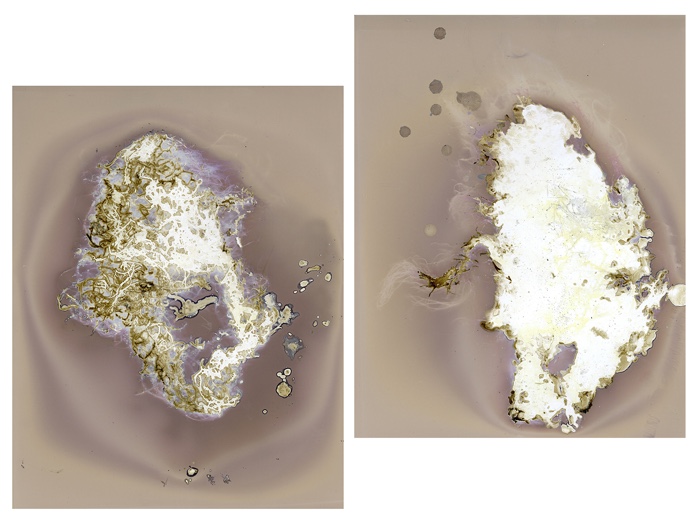
Hannah Fletcher, What Remains: The Root and The Radical, 2018

Hannah Fletcher, What Remains: The Root and The Radical, 2018
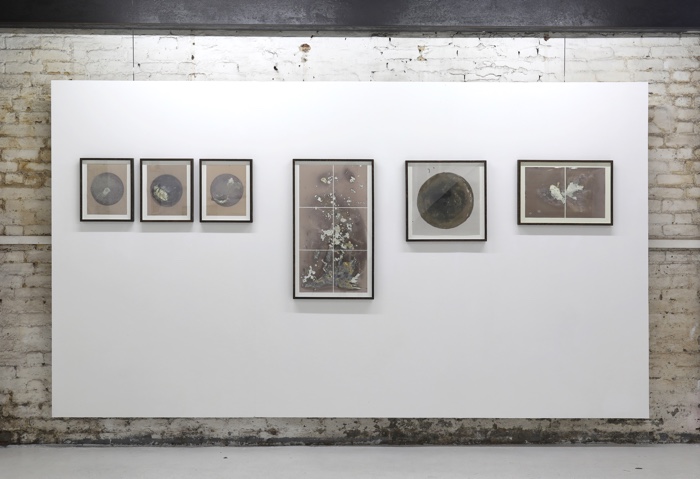
Hannah Fletcher, What Remains: The Root and The Radical, 2018
What Remains: The Root and The Radical explores the fascinating scientific field that studies the cognitive abilities of plants. Could you tell us how the images you created for this series illustrate or comment on plant intelligence?
Recently, more and more, plants are being described as ‘intelligent bodies’ and ‘social organisms’. In the late 1800s, Charles Darwin was the first to suggest that the tip of the roots in plants is akin to the brain of some animals. Since then, the possibility of mental capacities and cognitive abilities of plants has become an exciting field of research. In his book, The Hidden Life of Trees, Peter Wohlleben states that the roots of a tree ‘is where the tree equivalent of a brain is located’. The root network is in control of all chemical activity in the plant, they absorb and release essential substances. In a similar way, our own internal processes are too controlled by chemical messengers.
Working in a pseudo-scientific manner, I subjected plants to photographic chemicals, to try and understand what, if any, of the photographic material can be processed. Aiming to some how visualise the unobserved and unseen information contained within the roots. Roots were submerged into photographic chemistry and then reapplied to photographic surfaces, allowing the uptake of the plant to dictate the form of the image. The movement of the roots marking themselves along the paper.
In other works in this series I scored the surface of the paper, as if it was the surface of the earth, encouraging the chemistry to penetrate bellow the resin coated surface, searching for the structure; the root of the paper.
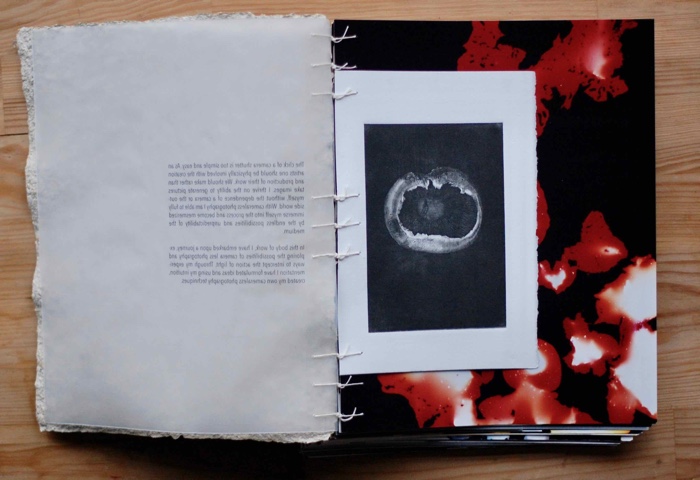
Hannah Fletcher, The Mushroom Book, 2015
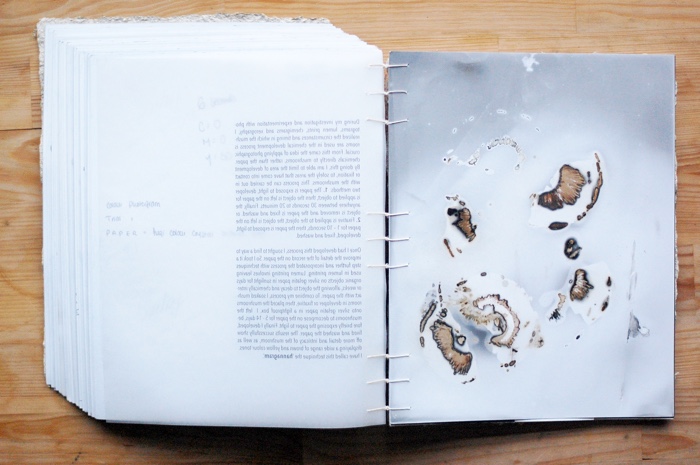
Hannah Fletcher, The Mushroom Book, 2015
Has your practice and more generally your interest in the environment altered the way you look at photography? Can you still enjoy a photography exhibition in a museum or gallery and forget what those images cost the earth?
It’s important to be able to look at photography and art in general without preconceived ideas and judgements. I am not thinking about environmental concerns all the time, otherwise I would really struggle to enjoy life. Everything we do has an impact and a consequence on the environment, but that does not mean we should not enjoy what is out there or sit back and watch the fire burn.
This is why I started The Sustainable Darkroom Project, I recognise the importance to empower individuals to make different choices. The more the individual consciousness grows, the more collective power we have. The closer we get to pulling down some of these barriers and opening up the flood gates.
The project is designed to build collective power within and opposing the current photographic industry. I want to encourage and empower you, as makers, as thinkers and as doers to have the knowledge and awareness of the materials and processes you are using. To understand the relationship between the things you use and the planet you live on.
The Sustainable Darkroom is an international project designed to educate, to learn through sharing and collaborative research. To encourage mistakes to be made and crazy ideas and ideals to be tested. With each new residency, workshop, talk or event, we get a little bit closer to understanding this word sustainable and the role it plays in every aspect of the photographic industry and beyond.
I recognise that we still have a long way to go and that a lot of the ideas, recipes and suggestions are not yet rigorously tested or scrutinised. This initiative is open for all to be involved with, all to learn from, all to add to and all to question. We will continue to experiment and adapt as we learn.
Thanks Hannah!
